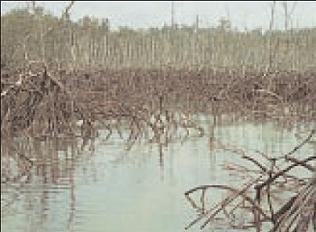|
FATE AND EFFECTS OF OIL
Oil slicks enter mangrove forests when the tide is high, and are deposited on the aerial roots and sediment surface as the tide recedes. This process commonly leads to a patchy distribution of the oil and its effects, because different places within the forests are at different tidal heights. It can be very difficult to assess the extent and distribution of oiling in a dense forest shortly after a spill, because oil on the ground can be invisible from the air if hidden by a closed forest canopy, and invisible from the sea if the seaward fringe has escaped contamination because of its lower tidal height. Aerial survey can be used for assessment at a later stage if the oil kills the mangroves, when the dead areas are easily visible because of defoliation.
Mangroves can be killed by heavy or viscous oil that covers the trees’ breathing pores thereby asphyxiating the subsurface roots which depend on the pores for oxygen.
Mangroves can also be killed through the toxicity of substances in the oil, especially lower molecular weight aromatic compounds, which damage cell membranes in the subsurface roots. This in turn impairs the normal salt exclusion process, and the resulting influx of salt is a source of stress to the plants.
The organisms among and on the mangrove trees are affected in two ways. First, there may be heavy mortalities as a direct result of the oil. For example, oil may penetrate burrows in the sediments, killing crabs and worms, or coat molluscs on the sediment surface and aerial roots. Second, dead trees rot quickly, leading to loss of habitat for organisms living in the branches and canopy of the trees, and in the aerial root systems. Large falling trees or branches can also be a hazard for rehabilitation workers.
Over time several factors reduce the toxicity of oil that has been deposited in mangrove forests. The amount of oil in the soil is reduced by rain and tides. In addition the oil weathers, a process in which some of the more toxic volatile fractions evaporate, and chemical changes such as oxidation make the residual oil less toxic. Eventually the soil can support mangrove growth once more, with the time-scale involved varying according to local conditions such as the amount of water circulation in the immediate area. Oil degradation can be rapid in the tropics and there are instances of natural seedling establishment and growth in oiled soil within a year of a spill. These processes can be slower if oil degradation is inhibited because of anaerobic soil conditions. Another possibility is that high tannin concentrations in some mangrove peat may inhibit oil-degrading bacteria. |
|
 |
 |
Source :
BIOLOGICAL IMPACTS OF OIL POLLUTION: MANGROVES
International Petroleum Industry Environmental Conservation Association
Next >>>
|

